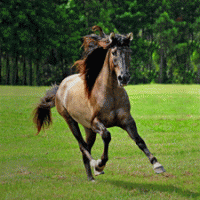Gait of Marsh Tacky Horses: Exciting Research

by Dr. Molly Nicodemus, PhD., Gaited Locomotive Research Program, Mississippi State University and Jeannette Beranger, ALBC Research and Technical Programs Manager
Due to the breed’s Colonial Spanish heritage the Marsh Tacky was thought by some to be gaited, but there had never been any research conducted concerning the gaits. One long time breeder once described it as a “rocking chair gait.” One thing for certain is that some of the horses were found to be particularly comfortable under saddle. This thinking was the start of a project to try and understand why the Marsh Tacky was often different from the feel of other horses when ridden. A study was undertaken by Dr. Molly Nicodemus of Mississippi State University (MSU) and American Livestock Breeds Conservancy (ALBC) to explore and define the gait of the Marsh Tacky using video of the horses analyzed with temporal variable measurements on the horses. Ten horses from various bloodlines were selected and filmed by ALBC staff while the horses performed their intermediate gait. Using frame-by-frame analysis, ten strides that were consistent with clearly visible hoof contact and lift-off were evaluated for the study by MSU. An interesting development occurred as every one of the horses Dr. Nicodemus viewed had periods of "gaiting." This meant that they demonstrated a symmetrical, 4-beat stepping (no suspension) gait with a lateral footfall sequence (meaning the footfall was left hind, left fore, right hind, right fore) in which all of these variables are similar to the walk and other gaited horse gaits (running walk, rack, fox trot, etc.).
What Dr. Nicodemus found is that the Marsh Tackies perform a "broken trot" (similar to the fox trot of the Missouri Fox Trotter horse.) Instead of diagonal pairs, the two diagonal limbs disassociate creating instead of a 2-beat gait a 4-beat gait with diagonal couplets. In place of the suspension, the horse has created a quadrupedal support phase where all four limbs are on the ground. The durations, timing, and limb support are more similar to the marcha batida of the Mangalarga Marchador, the National horse of Brazil. The fox trot does not demonstrate quadrupedal support. Instead, it shows more tripedal support, but the marcha batida does show quadrupedal support along with the diagonal couplets. Both the Mangalarga Marchador and Marsh Tacky breeds share similar Spanish ancestries which may explain the similarities in their gaits.
At faster speeds than what was measured in the research study, the Tackies can produce a true trot, which is similar to other gaited breeds which can produce either a pace or trot at faster speeds (depending on the breed.) Some horses in the study could not hold the gait as well at the speeds that were observed, which can make the gaits feel and look rough as they switch in and out of the trot and broken trot. Conformationally, some horses may be suited better for this gait than others, but the study has not yet gotten that far into the research to understand this point. The lack of suspension, periods of quadrupedal support, and the longer periods of stance (where the hoof is more on the ground) assist the horse in traveling through such terrain as marshy land.
The next step for MSU in research will be to look at joint angles, head displacements, back and croup movements to determine further what they are doing with the body to assist in producing the gait. With the current findings, the Marsh Tacky can be considered gaited. The findings were published in the Journal of Animal Science in 2009. The gait variables found in the study will assist in identifying characteristics that are unique to the Marsh Tacky in comparison to other gaited horse breeds.
Dr. Nicodemus writes “While the gait looks like the marcha batida, it is not exactly the same so it truly needs its own name” and has invited the Carolina Marsh Tacky Association to coin a name for their breed’s gait.
Interestingly because the gait of the Marsh Tacky is definitely unlike anything Dr. Nicodemus has ever seen in other gaited horses, it has encouraged further research on other Spanish Colonial breeds. Work is currently under way to collect of video footage of the other Colonial Spanish horse breeds listed on the ALBC Conservation Priority List.
A big “thanks” goes out to all of the owners who helped collect video footage of their horses.
Photo © Dwain Snyder at www.EquestrianImages.us
Purchase Equitrekking DVDs, the Equitrekking Travel Adventures on Horseback book and more at ShopDarley.com. Learn about equestrian vacations and book horseback riding adventures at EquitrekkingTravel.com




